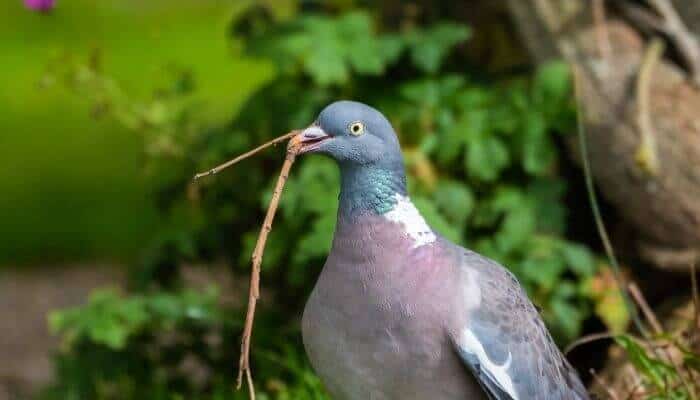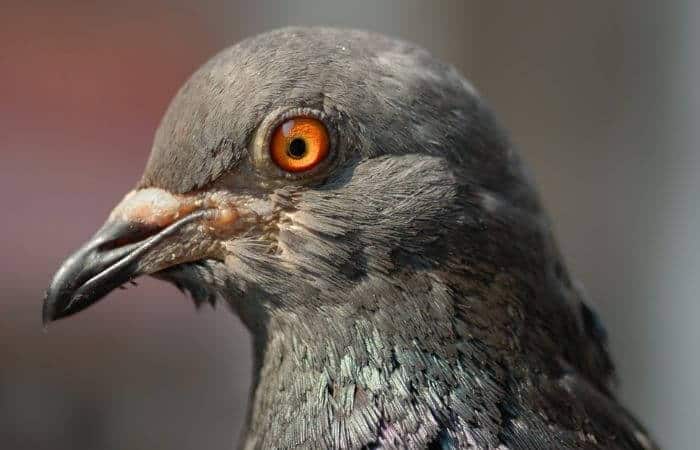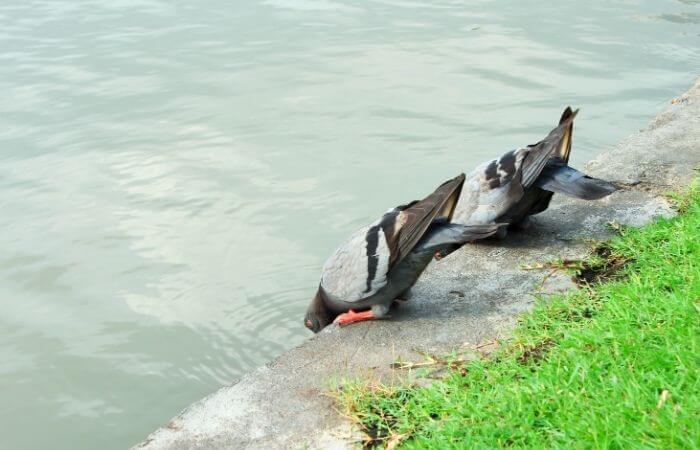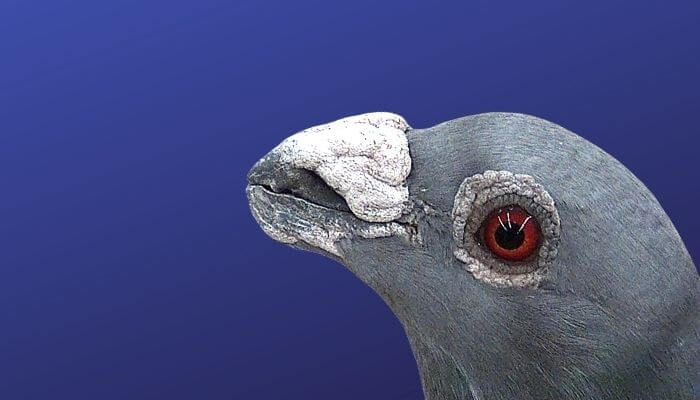The pigeon uses its beak to eat, probe for food, preen, feed its young, courtship and fight.
Construction of a Pigeon Beak
Beak or bill? In any bird, the bill is the entire mouth structure, and the beak is technically only the external surface of the mouth.
The bill is constructed of a bony framework with the upper portion being the maxillary rostrum (premaxilla bone and rhinotheca) and the lower portion being the mandibular rostrum (mandible bone and gnathotheca).
The beak is the outer sheath covering the jawbones. It is “glued” to the bones by a vascular layer that contains connective tissue, nerves and blood vessels.

It is made from keratin, which is a tough insoluble protein that feathers, fur, hooves, antlers and horns are made from in animals and fingernails and hair in humans.
The edges of the beak (tomia) dictate the type of feeder the bird is. In the case of pigeons, they are granivorous which means their tomia are ridged to help the bird to slice through a seed’s outer hull.
Another part of the beak is the cere.
Only a handful of bird species have these, namely raptors, owls, skuas, parrots, turkeys and pigeons.
It is a small fleshy, waxy mound at the base of the upper beak that protects the nares (nostrils) although its other functions, if any, are unclear.
Much like human fingernails, a pigeon’s beak is always growing.
The beak grows from the base outward.
The outer layer is shed often, being replaced with new keratin as it occurs.

The bones of the bill do not grow continuously.
The beak can grow between one and three inches in a year but because of wear, the beak will always look about the same size.
The colour of the beak is determined by pigments in the epidermal layer, the shade being arrived at by the combination of melanins and carotenoids.
Baby Pigeon Egg Tooth
Baby pigeons have an egg tooth that adults do not.
As the name implies, this a calcified protrusion on the baby bird’s beak that enables it to break out of its shell when it’s time to hatch.
It’s found on the rostro dorsal side of the bird’s upper beak and can be seen as the baby hatches.
Within a few, the egg tooth disappears, and the beak smooths out, becoming the regular beak of an adult pigeon.
The Shape of a Pigeon’s Beak
There are many different recognised beak shapes – each of them suited to the diet of the bird.
The shape of the pigeon’s beak is designed for them to dine on seeds, plants and fruits.
How a Pigeon Uses its Beak for Eating and Drinking
A pigeon’s beak is made to crack through shells and pull plants and fruits into smaller pieces.
Those pieces of food are pushed to the back of the pigeon’s throat using its tongue.
The food then makes its way down the oesophagus and enters the digestive tract.
Most birds drink in a similar fashion, but pigeons are an exception.

You’ll see many other species put their face in the water, then tilt their heads back to swallow.
Pigeons, on the other hand, put their heads into the water and suck it up.
Unlike other birds, pigeons are able to get the water into their throats and down to their stomachs without having to look upward to do so.
Common Pigeon Beak Problems:
There are some instances where a pigeon may have a deformed or unhealthy beak. Understanding the problem allows for proper treatment.
1. Scissored Beak
A scissored beak happens when one side of the pigeon’s beak crosses over the other side and can occur due to trauma or disease.
This can interfere with flying and eating and the beak will need to be trimmed to keep the pigeon healthy and safe.
2. Hook Beak
Hook beak refers to an upper beak that is longer than it should be, often growing into a hook shape at the end.
This will make it virtually impossible for the pigeon to pick up seeds and eat, causing it to starve. The beak can be trimmed but must be done carefully to prevent bleeding.
3. Bent Upper Beak
A bent upper beak is usually the result of trauma and looks like it’s bent backwards into the throat. It may also appear to have broken off.
The tip of the upper beak may break through the lower beak, allowing the tip to show through the break. If this occurs, it’s best to let an experienced veterinarian manipulate the beak back into the proper position.
4. Beak Pustules
If you see pustules (spot filled with pus) on the beak, you may be dealing with pigeon pox.
The lumps often also appear on the pigeon’s feet. This is a virus that only affects pigeons and can’t transfer to humans or other animals.
It can spread among pigeons via their drinking water, but the condition is generally mild.
In severe cases, it can interfere with vision and eating, so seeking treatment from a veterinarian is important for the bird’s survival.
How to Keep Pigeons’ Beaks Healthy
One of the easiest ways to keep a pigeon’s beak healthy is to be sure it’s eating a nutritious diet.
Pigeon feed is generally a good choice for everyday meals, but you should also offer a variety of fruits, vegetables, seeds and nuts to cover all the vitamins a pigeon needs.
Chew toys also promote a healthy beak. This promotes a healthy bill, and a variety of options offer the most benefit. Ropes, wooden beads, coconut and mineral blocks are all good choices.
Rotate the pigeon toys regularly to ensure that they are all being put to good use.

A conditioning perch gives your bird a place to wipe its beak. This helps keep the beak clean and reduces the risk of health issues that can be blamed on bacteria, built-up food and other dirt stuck on the bird’s beak.
Offering cuttlebones is another option that many bird owners swear by.
The bones of a cuttlefish offer a variety of vitamins and minerals, primarily those that promote healthy bone formation and blood clotting. Other nutrients include calcium carbonate, zinc, iron and copper.
Collectively, these nutrients support red blood cell formation, healthy immunity and proper circulation. Hang a cuttlebone in your pigeon loft so they can chew on it.
A bird’s beak is a sensitive organ with many sensory receptors and therefore when injured or diseased can cause pain.
It is always better to seek the advice of a vet or pigeon-friendly rescue centre before you attempt any treatment yourself, especially beak trimming.

This article was written by our qualified veterinarian Cristina.
This is part of our commitment to providing you with the most trustworthy veterinary advice for your pigeons.
Sources:
